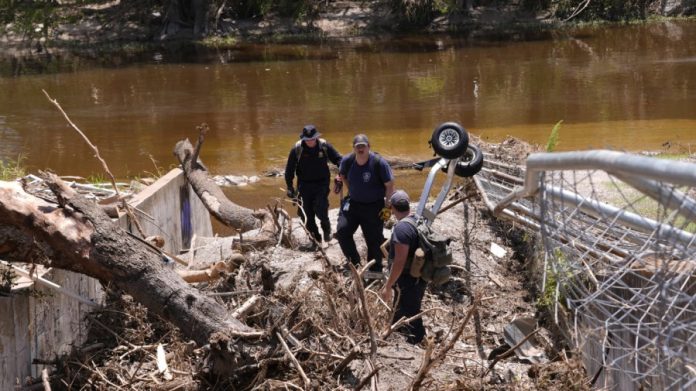
The Trump administration appears to be drastically reducing the federal funds it offers to help states head off future natural disasters, a decision that could come under fire as the White House faces scrutiny over its response to Texas’s deadly flooding.
The administration has responded to criticism of its handling of the Texas floods with claims that it is “remaking” the Federal Emergency Management Agency (FEMA) to better help states.
But after the deadly Independence Day floods, the administration declined to provide Texas with access to a tranche of FEMA funds aimed at heading off the next disaster — money intended to pay for things such as warning systems, tornado shelters and anti-flood measures.
A review of federal documents by The Hill shows that the administration denied such “hazard mitigation” funds to states after 16 out of 18 flood disasters during the Trump presidency, with both of the approvals coming before mid-March.
In May, children in a Missouri elementary school sheltered from a tornado that shattered windows and ripped gutters off the building inside a safe room purchased with hazard mitigation money issued after the deadly 2011 Joplin tornado.
Though the Trump administration approved Missouri’s disaster declaration, it refused the hazard mitigation funds the state requested to buy generators and more outdoor warning sirens, state officials told The Hill. Missouri is appealing that decision.
In neighboring Oklahoma, the Biden administration had in November approved hazard mitigation funding for wildfires and straight-line winds.
But even as those funds went out, more wildfires, driven by straight-line winds, were raging across the Sooner State. President Trump issued a disaster declaration on the last day of the weeklong emergency — but denied hazard mitigation funding.
It was the first time in at least 15 years that Oklahoma wasn’t approved for requested hazard mitigation, according to state emergency management officials.
This pivot — which breaks longstanding federal precedent — comes amid steep Trump cuts to FEMA, which he has also talked about eliminating entirely, as well as cuts to the Department of Housing and Urban Development (HUD) and the federal forecasting and research apparatus.
Veterans of these agencies told The Hill there has been appetite for reform and arguments made for shifting more responsibility to the states.
“But this is like, ‘You need an appendectomy? Well, let’s get the garden shears,’” said Candace Valenzuela, former HUD director for the region that includes Texas.
Experts say cutting off hazard mitigation funds after floods marks a major shift in federal priorities.
FEMA has traditionally given states 15 to 20 percent of the disaster response budget to help prevent future catastrophes — spending the Congressional Budget Office (CBO) found pays for itself by at least $2 saved for every $1 invested.
That return is even greater for flood mitigation, where the CBO found every dollar spent yields $5 to $8 in avoided damages.
And that benefit is growing. Over the past decade, floods have cost the U.S. an average of $46 billion a year — or $135 annually per American — a figure expected to rise to as much as $60 billion by midcentury as the atmosphere warms and holds more moisture.
A wetter atmosphere, in turn, means more extreme rainfall such as the deluge that hit Central Texas earlier this month.
Former meteorologist and National Weather Service (NWS) union legislative director John Sokich said he’s seen more such downpours “in the last 10 years than I saw in my 35 years before that.”
Those worsening events make proactive spending even more effective, said Chad Berginnis, head of the Association of State Floodplain Managers (ASFPM).
“If you have more and more extreme events in the area you’ve mitigated, your benefits come faster,” Berginnis said.
The administration has also frozen a major flood mitigation program and clawed back funds from flood control projects nationwide that were already underway.
Last week, a coalition of 20 blue and purple states sued the federal government over the clawback of funding for the Building Resilient Infrastructure and Communities (BRIC) program, which began under the first Trump administration.
Money pulled from BRIC included funds that would have paid for an Oklahoma flood warning system, a North Texas flood control dam and $1 billion in flood control projects across the Chesapeake Bay.
“The impact of the shutdown has been devastating,” the states wrote in their suit. “Communities across the country are being forced to delay, scale back, or cancel hundreds of mitigation projects,” many of which had cost millions and had taken years to plan and permit.
“In the meantime, Americans across the country face a higher risk of harm from natural disasters,” the suit added.
The states also argued the pullback was illegal since Congress made forward-looking mitigation one of FEMA’s core responsibilities in 1997.
The administration did not respond to repeated requests for comment on the shift in FEMA strategy.
Assistant Homeland Security Secretary Tricia McLaughlin has said the administration is “leading a historic, first-of-its-kind approach to disaster funding.”
That approach, she said, means “providing upfront recovery support — moving money faster than ever and jump starting recovery,” while pivoting away from “bloated, D.C.-centric dead weight to a lean, deployable disaster force” that shifts responsibility to the states.
But emergency managers say the administration is cutting off vital resources that states and municipalities need to avoid financial ruin from worsening disasters.
“Mitigation is a lifeline,” Berginnis said. “It’s a way out of a really bad cycle of disaster, damage, repair, damage that a lot of folks of modest means really can’t escape.”
As a state emergency manager in Ohio, he said he saw FEMA hazard mitigation funding change lives by allowing the state to buy out flood-prone properties.
By contrast, FEMA’s “individual assistance” programs, which the administration continues to offer, only cover structural repairs, often for homes likely to flood again.
“When I presented a check to buy out his property, the owner said, ‘This is the only chance for me and my family to get our lives back to normal,’” Berginnis recalled.
In addition to dramatically cutting back funds to help states and municipalities prepare for the next flood, the administration also quietly changed FEMA standards to make it easier to build in floodplains.
One thing amplifying flood danger in the United States is that the nation’s builders, insurers and emergency managers often don’t even know how bad the flood risk is because it has never been assessed for most of the country’s creeks and streams.
The deadly July 4 flooding that swept away more than two dozen children and counselors from Camp Mystic in Hunt, Texas, for example, came when Cypress Creek burst its banks. That risk was obscured, Berginnis noted, because like two-thirds of similar waterways around the country, its floodways have never been mapped.
ASFPM has estimated that a complete re-mapping project would cost about $3 billion to $12 billion — just 3 to 25 percent the annual cost of flood repair, which they say that mapping would reduce. Once that project was done, they estimated, keeping it up to date would cost $100 million to $500 million per year, or between 0.2 and 1 percent of current annual spending on flood damages.
This is not money that the current administration seems eager to spend, however. Instead, it is moving away from spending on forecasting or research — including into how to best warn communities when deadly threats are coming their way.
DOGE cuts have disrupted a NWS reorganization meant to centralize operations so field offices could spend more time helping local emergency managers interpret often-ambiguous forecasts, agency veterans said.
That program had aimed to address the challenge that emergencies like the one in Kerr County are low-likelihood but high-impact, which can breed complacency until it’s too late.
Rather than pivot, NWS is “trying to keep its head above water,” said Alan Gerard, a former NOAA warnings expert who took a buyout this year. He warned that other cuts threaten research to understand the novel weather patterns of a hotter planet — research that could one day give communities like Kerr County six hours’ warning before fast-moving storms.
“That stuff is still years away — both from the physical science aspect, and the social science of helping people understand it,” he said. If the Trump cuts go through, he said, “that would all stop.”

